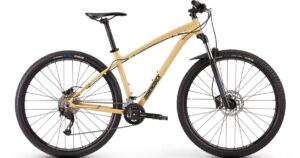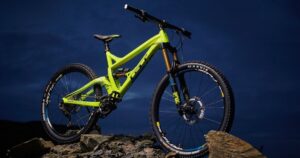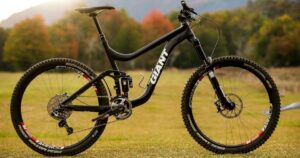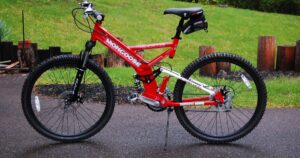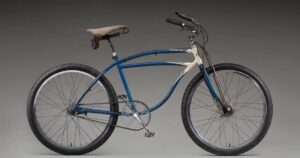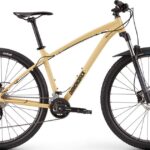Women’s mountain bikes are specifically designed to accommodate the unique needs and preferences of female riders. These bikes often feature frames with adjusted geometry to fit the proportions and anatomy of women more comfortably. The frame might have a lower top tube, allowing for easier mounting and dismounting, catering to varying heights and inseams. Additionally, handlebars and grips might be narrower to suit smaller hands, offering better control and comfort during rides.
Saddles on women’s mountain bikes often differ, designed to accommodate pelvic bone structure and provide greater comfort on longer rides. Suspension systems and shock absorbers might also be tuned differently to accommodate lighter body weights. These modifications aim to enhance the overall riding experience, ensuring that female riders can enjoy the trails with confidence, comfort, and optimal performance. Whether for leisurely rides or competitive ventures, women’s mountain bikes are tailored to meet the specific ergonomic and functional needs of female cyclists.
Choosing the Right Women’s Mountain Bike
Certainly! When selecting the perfect women’s mountain bike, consider these essential factors:
Frame Size and Fit
Choosing the right frame size and fit for a women’s mountain bike is pivotal for comfort and performance. A well-fitted frame ensures proper riding posture, preventing strain and enhancing control. Women-specific designs consider body proportions, offering tailored geometry, saddle, and handlebar widths.
A comfortable fit reduces fatigue on long rides, promoting confidence and maneuverability, making the frame size and fit a critical aspect in enjoying a seamless and enjoyable biking experience.
Women-Specific Design
Women-specific designs in mountain bikes cater to female riders’ unique anatomy and preferences. These designs consider differences in body geometry, offering adjusted frame shapes, narrower handlebars, and anatomically designed saddles. Such adaptations enhance comfort, optimizing riding experiences. Beyond physical adjustments, these designs often focus on color schemes and aesthetics appealing to women
Overall, women-specific design aims to provide a more comfortable, efficient, and enjoyable biking experience tailored specifically to female riders.
Suspension Type
The suspension type in women’s mountain bikes, whether hardtail or full-suspension, significantly impacts ride quality. Hardtail bikes feature front suspension, ideal for smoother trails and efficient climbing, offering lighter weight and simpler maintenance.
On the other hand, full-suspension bikes incorporate front and rear suspensions, absorbing rough terrain for enhanced comfort and control, perfect for challenging trails. Choosing the right suspension type depends on riding preferences and the terrain encountered for an optimal biking experience.
Wheel Size
The wheel size in women’s mountain bikes, commonly 27.5-inch or 29-inch, profoundly influences ride characteristics. The 27.5-inch wheels offer nimble handling and agility, ideal for tighter trails and maneuverability.
Conversely, 29-inch wheels provide better roll-over ability and stability over obstacles, suited for rougher terrain and faster rides. Selecting the appropriate wheel size depends on riding style, terrain preferences, and desired balance between agility and stability for an enjoyable biking experience.
Brakes and Gearing
Brakes and gearing are crucial aspects of women’s mountain bikes, influencing control and performance. Disc brakes offer reliable stopping power in varied conditions, while rim brakes are lightweight and easy to maintain. Gearing affects pedaling efficiency, with a wide range accommodating diverse terrains. Consider gear ratios for climbing ease and speed. Balancing brake type and gear range ensures confident descents and efficient climbs, vital for an enjoyable and safe riding experience.
Remember, finding the right women’s mountain bike involves a balance between personal preferences, fit, performance, and budget. Take your time and explore various options before making a final decision.
Key Features and Components
When it comes to the key features and components of women’s mountain bikes, several aspects stand out:
Frame: Considered the bike’s backbone, frames come in various materials like aluminum, carbon, or steel, offering different weights and ride characteristics.
Suspension: Determines how the bike absorbs shock. Options include hardtail (front suspension) or full-suspension for both front and rear shock absorption.
Wheel Size: Typically 27.5-inch or 29-inch, affecting maneuverability, stability, and how the bike rolls over obstacles.
Brakes: Choose between disc brakes (offering consistent stopping power) or rim brakes (lightweight and easy to maintain).
Gearing: Refers to the range and number of gears, influencing pedaling efficiency on various terrains.
Handlebars and Saddle: Women-specific designs might feature narrower handlebars and anatomically designed saddles for enhanced comfort.
Tires: Tread patterns and widths designed for specific terrain types, affecting traction and control.
Components Quality: Consider the quality of shifters, derailleurs, and other parts impacting the bike’s overall performance and durability.
Understanding these features and components helps in selecting a women’s mountain bike tailored to individual preferences and riding styles.
Women-Specific Designs and Technology
Women-specific designs and technology in mountain bikes cater to female riders’ unique anatomies and preferences. These bikes often feature adjusted geometries, accommodating shorter torsos and longer legs. Narrower handlebars and women-specific saddles enhance comfort. Advanced suspension tuning considers lighter body weights and differing strength distributions.
Additionally, aesthetically appealing color schemes and design elements often complement these bikes. Altogether, these specialized designs and technologies aim to optimize comfort, performance, and overall biking experiences for women.
Top Brands in Women’s Mountain Bikes
Certainly! Here are five top brands renowned for their women’s mountain bikes:
Liv Cycling
Liv Cycling specializes in women’s-specific bikes, focusing on tailored designs for female riders. Their mountain bikes feature customized geometries, components, and technologies to ensure comfort and optimal performance. With a commitment to empowering women in cycling, Liv Cycling offers a diverse range of high-quality bikes suited for various riding styles and abilities.
Juliana Bicycles
Juliana Bicycles is renowned for crafting top-tier mountain bikes exclusively for women. Their dedication reflects in precision engineering, offering high-performance rides tailored to female riders. With meticulous attention to detail in design and technology, Juliana Bicycles ensures optimal comfort and exceptional handling, empowering women across diverse terrains and trails.
Trek Bikes
Trek Bikes stands as a leader, offering an extensive line of women’s mountain bikes catering to various skill levels and preferences. Renowned for innovative designs and cutting-edge technology, Trek delivers exceptional performance and comfort. With a commitment to quality, their bikes empower women riders on trails worldwide.
Specialized Bicycles
Specialized Bicycles is revered for crafting women-specific mountain bikes, featuring meticulous design and top-tier components. Their commitment to innovation results in bikes tailored for female riders, delivering exceptional performance and comfort. With a focus on pushing boundaries, Specialized bikes empower women to excel on any trail or terrain.
Santa Cruz Bicycles
Santa Cruz Bicycles is synonymous with durability and precision in women’s mountain bikes. Known for their specialized designs and cutting-edge technology, their bikes offer unmatched performance and handling. With a focus on quality craftsmanship, Santa Cruz empowers women riders to conquer trails confidently, setting new standards in mountain biking.
Maintenance and Care Tips
Maintaining a women’s mountain bike ensures longevity and peak performance:
Regular Cleaning: Wash dirt and grime off components with a mild soap and water solution. Dry thoroughly to prevent rust.
Chain Care: Keep the chain lubricated and clean. Replace when worn to prevent damage to other drivetrain parts.
Suspension Maintenance: Follow manufacturer guidelines for fork and shock maintenance. Keep seals clean and check for leaks regularly.
Tire Pressure: Maintain optimal tire pressure for better traction and performance. Inspect for wear and replace if needed.
Brake Checks: Regularly examine brake pads for wear and ensure proper alignment for effective braking.
Check Bolts and Fasteners: Periodically inspect and tighten bolts to prevent loosening during rides.
Storage: Store the bike in a dry, covered area to prevent exposure to elements that can cause damage or corrosion.
Professional Tune-Ups: Consider periodic professional checks for in-depth maintenance and adjustments.
By routinely caring for your women’s mountain bike, you’ll ensure a smoother, safer, and more enjoyable riding experience.
Benefits of Women’s-Specific Mountain Bikes
Women’s-specific mountain bikes offer tailored features catering to female riders, yielding several distinct advantages. These bikes consider anatomical differences, featuring adjusted geometries and components that enhance comfort and handling. Improved ergonomics, including narrower handlebars and specialized saddles, ensure better posture and reduced strain during rides.
Additionally, women’s-specific designs often focus on aesthetics and color schemes that resonate with female riders, fostering a sense of personalization and empowerment. Ultimately, these specialized mountain bikes not only deliver enhanced comfort and performance but also contribute to a more inclusive and enjoyable biking experience for women.
Riding Techniques and Skills Development
Mastering riding techniques is key to enjoying women’s mountain biking:
Body Positioning: Learn to shift weight for balance and control. Keep elbows and knees bent, allowing the bike to maneuver smoothly.
Cornering: Approach turns with controlled speed, leaning the bike while keeping your body upright for better traction.
Climbing and Descending: Utilize gears efficiently when climbing, and shift your weight back when descending for stability.
Braking: Practice modulating brake pressure for controlled stopping power without skidding.
Trail Awareness: Scan the trail ahead, anticipating obstacles, and choose the best line to navigate challenges.
Pump Tracks and Jumps: Develop skills on pump tracks to improve rhythm and learn controlled jumps for more advanced trails.
Balance and Control: Enhance balance by practicing track stands and slow-speed maneuvers to handle technical sections better.
Seek Guidance: Consider classes or guided rides to refine skills and gain confidence on different terrains.
Dedicating time to these techniques boosts confidence and enjoyment while exploring diverse trails on women’s mountain bikes.
Safety Gear for Women Mountain Bikers
Safety gear is paramount for women mountain bikers, ensuring protection and confidence on trails. A well-fitted helmet is non-negotiable, safeguarding against head injuries. Consider women-specific helmets for better fit and comfort. Protective eyewear shields from debris, enhancing vision. Gloves offer grip and guard against abrasions.
Knee and elbow pads minimize impact during falls, while proper footwear provides stability and support. Reflective clothing enhances visibility, crucial for riding in low-light conditions. Prioritizing safety gear fosters a secure and enjoyable biking experience, allowing women riders to push boundaries with peace of mind.
Growing Trends in Women’s Mountain Biking
Women’s mountain biking is experiencing dynamic shifts in trends:
Increased Participation: More women are joining the sport, fostering a vibrant and inclusive community. Events and clubs tailored to female riders encourage growth.
Technology Advancements: Innovations in bike design and gear cater specifically to women, focusing on comfort, performance, and aesthetics.
Empowerment and Representation: Women-specific campaigns and role models in the biking industry inspire confidence and participation, breaking gender barriers.
Skill Development Initiatives: Educational programs and clinics geared toward women empower skill development, fostering competence and camaraderie.
Diverse Trail Offerings: Trails catering to various skill levels and preferences attract a broader range of female riders, promoting exploration and skill enhancement.
Advocacy and Support: Increased advocacy for safety, accessibility, and equality in mountain biking provides a supportive environment for women riders.
This evolving landscape signifies a thriving community where women’s mountain biking continues to grow, innovate, and flourish.
Conclusion
Women’s mountain biking has evolved into a vibrant and inclusive realm, offering tailored experiences and opportunities for female riders. The emphasis on women-specific designs, technology, and community engagement reflects a significant shift in the biking landscape. With advancements in gear, increased representation, and a supportive community, women are embracing the sport more than ever.
These mountain bikes, customized to cater to female anatomy and preferences, not only provide enhanced comfort and performance but also symbolize empowerment and inclusion. As more women join the biking community, diverse trails, skill development initiatives, and technological innovations continue to pave the way for an enriching and dynamic experience.
The growing trends underscore a future where women’s mountain biking stands as a pillar of diversity, skill development, and empowerment, promising a thrilling journey for riders and fostering a welcoming space for all enthusiasts.



